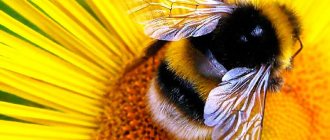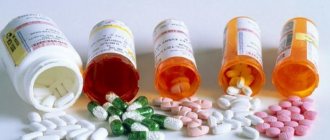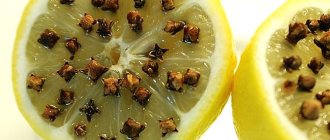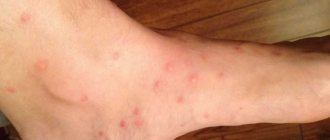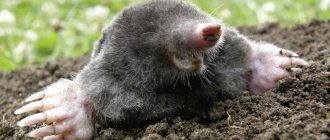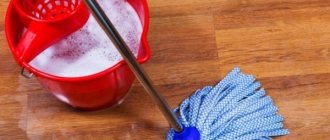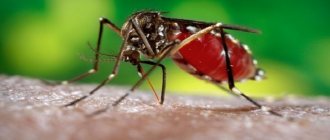27.02.2019
A wasp sting is a way to protect an insect from external factors that it considers threatening: sudden movements, odors, a threat to the nest. One of the consequences of a wasp sting is swelling. You can get rid of it with the help of various medications and folk remedies. In some cases, the help of a doctor is necessary.
Causes of swelling after a wasp sting
One of the features of wasps is the fact that one insect can bite several times. In this they differ from bees, whose sting is jagged and remains in the human skin, and its loss leads to the death of the insect. The wasp's sting is sharp and smooth.
One of the causes of swelling after a wasp sting is damage to the skin or mucous membranes. In the second case, swelling is more pronounced, since such areas are more tender and sensitive. Although the wasp has a smooth sting, the integrity of the skin and mucous membranes is inevitably damaged when bitten, so the affected area swells.
The main cause of swelling after a wasp sting is the injection of poison - it is contained in a special capsule and is produced by the glands of the insect. Swelling in this case is an allergic reaction and a kind of immune response of the body. The stronger a person’s susceptibility to wasp venom, the more pronounced the swelling will be.
In addition to multiple bites and allergies to poison, severe swelling can develop in cases of weakened immunity and atopic dermatitis.
First aid
When providing first aid and further treatment after a wasp sting, you should understand the biochemical nature of the insect venom. Its entry into the wound causes an alkaline reaction, so acid is needed to neutralize it.
First aid after a wasp sting consists of the following measures:
- Wash the affected area with soap and water. The water should be at room temperature.
- The wasp does not leave its sting in the body of the victim, but this possibility cannot be excluded if the insect is killed during the bite. The sting must be removed. This can be done with tweezers or a needle, having previously disinfected the instrument. Under no circumstances should you remove the sting from the eye yourself.
- The bite site must be treated. To do this, you can use hydrogen peroxide or any alcohol tincture.
- Cold should be applied to the affected area. This could be a cloth soaked in cold water, an ice pack wrapped in a towel, or a bottle of cold water. Cold relieves swelling well and soothes pain - and the wasp bites are quite painful.
- After providing first aid, they resort to antihistamine tablets and products for external use. You can also drink Aspirin - the drug has an anti-inflammatory and analgesic effect, neutralizes toxins.
If a person injured by a wasp sting is allergic, then you should not hesitate. You must call an ambulance immediately. The victim requires intramuscular injection of adrenaline - this measure helps stop the spread of an acute allergic reaction.
Under no circumstances should you scratch the affected area. The bite site should be protected from contamination, otherwise a bacterial infection may develop.
What affects the degree of swelling
The severity of swelling after a wasp sting depends on the individual characteristics of the human body. The severity is influenced by the location of the injury. If an insect bites your leg or arm, it will be easier to bear than a bite to the eye, lip or face. The size of the swelling depends on the amount of poison that the wasp managed to release into human tissue. The more substances that enter the network of blood vessels, the more severe the reaction will be.
The composition of wasp venom depends on its variety.
The most dangerous are the “road” ones with an elongated body covered with clear stripes.
Wasp venom is dangerous to humans and provokes the following reactions in the body:
- damages surrounding epidermal cells;
- provokes an inflammatory process, which is accompanied by swelling and itching;
- due to the destruction of mast cells, an allergic reaction develops;
- nerve cells are exposed to the toxic effects of poison, which disrupts their conductivity;
- the release of histamine increases, which triggers an allergic reaction in the body.
Antihistamine tablets
One of the options for medication to relieve swelling after a wasp sting is antihistamine tablets. An allergic reaction to poison involves the release of histamine, a mediator of allergic reactions. Antihistamine tablets block it.
If you are stung by a wasp, you can use one of the following medications:
- Tavegil. The active composition of the tablets is represented by clemastine hydrofumarate. The drug can be given to children from 6 years of age; it is contraindicated during pregnancy and breastfeeding. Take the drug twice a day, adults - one tablet, children under 12 years old - half the dose.
- Suprastin. The active substance is chloropyramine hydrochloride. The medicine is contraindicated in infants, pregnancy, breastfeeding and exacerbation of bronchial asthma. An adult needs to take a Suprastin tablet 3-4 times a day. For a child, the dosage is reduced by 2-4 times; the medicine must be taken 2-3 times a day.
- Claritin. The drug is based on loratadine. It can be given to children from 2 years of age; the tablets are contraindicated during breastfeeding. You need to take one pill per day; if you weigh less than 30 kg, the dosage should be halved.
- Diazolin. The tablets are based on mebhydrolin napadisylate. The medicine is contraindicated in children under 3 years of age, pregnant and breastfeeding women, and those with peptic ulcer disease. Adults need to take 100 mg tablets up to 3 times a day. Children are prescribed the drug 50 mg - the dosage is calculated according to age, tablets must be taken up to 4 times a day.
- Erius. The active substance in the composition is desloratadine. The medicine is approved for children over 12 years of age (syrup is used for children younger), pregnancy and lactation are contraindications. The drug is taken one tablet per day.
Taking antihistamines should be discussed with your doctor. Contraindications must be taken into account. Any drug should not be taken if you are hypersensitive to at least one of its components.
Ointments for external use
Some topical products effectively eliminate swelling after wasp stings. They usually refer to antihistamines or glucocorticosteroids. You can read more about ointments for allergies here.
You can use the following medications:
- Fenistil. This antihistamine is produced in the form of a gel; the active substance is dimethindene maleate. Contraindications include children under one month of age, prostate adenoma in men, and angle-closure glaucoma. Treatment can be carried out up to 4 times a day.
- Hydrocortisone. The ointment is a glucocorticosteroid and is based on the substance of the same name. It can be used by children from 2 years of age. The bite site should be treated 1-3 times a day for a maximum of 2 weeks.
- Advantan. The drug is a glucocorticosteroid, available in the form of ointment and cream and is based on methylprednisolone aceponate. The bite site should be treated once a day. The product is contraindicated for rosacea, viral diseases, syphilitic or tuberculous skin lesions.
- Sinaflan. The ointment is based on the substance of the same name and is a glucocorticosteroid. It should not be used by children under 2 years of age, pregnant or breastfeeding women, or those with certain skin diseases. You can apply the ointment up to 4 times a day, after performing an antiseptic treatment.
- Elokom. The drug is a glucocorticoid, available in the form of cream and ointment, based on mometasone furoate. Do not use it during pregnancy, breastfeeding, or with viral or bacterial skin lesions. The bite site is treated once a day.
Some ointments need to be stored in the refrigerator. This is required by storage conditions, but a chilled product also quickly relieves swelling and soothes pain.
Folk remedies
You can also get rid of swelling after a wasp sting using folk remedies. The effect of the poison can be neutralized with an acid, such as table vinegar, citric acid or lemon juice, or tomatoes.
The following means are used to relieve swelling:
- Take activated carbon and acetylsalicylic acid, add one tablet to a glass of water. After dissolving the drugs, moisten a gauze pad in the liquid and apply to the affected area. Along with the swelling, the pain will go away.
- Mash a few parsley leaves and apply to the bite area
- You can also cope with swelling using a parsley compress - pour boiling water over the finely chopped greens, and after cooling, make a lotion. You can speed up the healing of the wound and draw out the poison by adding a plantain leaf to the parsley. Other ways to use parsley to eliminate swelling are described here.
- A salt compress works well for swelling. Dissolve a teaspoon of salt in a glass of water, moisten a gauze pad in the liquid and apply it to the affected area.
- Aloe provides a good effect. You can apply a napkin moistened with fresh plant juice to the bite site, or cut its leaf in half and apply it to the skin.
- It is effective to lubricate the bitten area with olive oil several times a day.
Folk remedies should be used carefully. They can also cause an allergic reaction.
Using Mother Nature's gifts
Our grandmothers also knew how and with what to treat the stings of small Hymenoptera predators at home. Quickly healing a broken knee or providing first aid for fainting without medications was a common thing for them. Let's learn how to use products that are always in the house. After all, if you are bitten by a bee or a yellowish predator, you cannot waste a minute.
To remove swelling, apply to the wound:
- A compress of fresh lime, lemon or calendula juice.
- A cut onion, half a tomato or a crushed clove of garlic.
- A paste of baking soda and water.
- Leaves of Kalanchoe, tansy or twigs of wormwood, crushed in the palms.
- Water compress made from aloe or golden mustache tincture.
- Grated green apple.
- A Validol tablet soaked in water.
Your hand is swollen at night: what to do? What helps better in this case? Even in ancient times, the scientist and physician Avicenna recommended using thyme for wasp stings. It is very simple to prepare the product at home - grind the leaves and flowers of the plant in a mortar. Apply a “green compress” to the wound - the inflammation will go away and the pain will subside. You can continue treatment with this remedy the next day.
To relieve swelling, you can use applications made of blue or white clay. Cosmetic clay is easy to buy at every pharmacy kiosk. Pour a little water and alcohol into the prepared clay powder, knead it like dough and roll out the cake. Apply it to the wound overnight and secure with an elastic bandage. By morning the clay will “pull out” the entire tumor.
Don't let small flying predators disturb your holiday! During the “wasp” period, use less cosmetics with strong odors. Do not chase yellow-black insects, avoid places where they accumulate in large numbers. Always have protective equipment with you. And yet, if you are bitten by a wasp, you already know how to remove the tumor. I wish you good health and joy from communicating with nature!
Home page
When is a doctor needed?
Medical attention for a wasp sting is necessary in several cases. One of them is a severe allergy to insect venom. In this case, the manifestations of an allergic reaction may be too strong.
A doctor's help is also required if a wasp bites certain parts of the body. This applies to the larynx, lips, tongue, eyes, and various mucous membranes. Damage to such areas, even without poison, can be dangerous.
Another factor that requires medical attention is multiple bites. This usually happens when a person disturbs a wasp's nest. Often this happens completely by accident - the nest may end up on a balcony, attic, or in the wall of a residential building. Multiple wasp bites that occur on the eyes or larynx are many times more dangerous. An ambulance should be called when an adult is bitten by 10 or more insects, and a child by 5 insects.
Wasps sting people quite often, but the real danger is only multiple bites, damage to the mucous membranes and an allergic reaction to insect venom. The consequence of a bite is swelling, which can be relieved with the help of medications and folk recipes.
Important Features
Most often, a wasp sting provokes quite unpleasant sensations, but not dangerous. The damaged area swells, begins to hurt, and then makes itself felt with severe itching. But after a few days, such symptoms go away on their own, even if no treatment was undertaken.
However, there are cases where a wasp sting leads to quite serious consequences, and sometimes even deadly. It is difficult to say what the complications will be. After all, the consequences of a bite depend on individual sensitivity to the poison. The type of insect is no less important.
Therefore, carefully consider whether you have become a victim of a bee or a wasp. The first is distinguished by its dense body and hairiness. The wasp is a slender insect. It is distinguished by its light color and minimal number of hairs. Below we will discuss how to relieve swelling from a wasp sting. If you are stung by a bee, then first aid will need to be somewhat different.
Most people are not even aware of their sensitivity to insects. Therefore, it is extremely important that there is a person nearby who can provide assistance correctly and who knows how to relieve swelling from a wasp sting.
